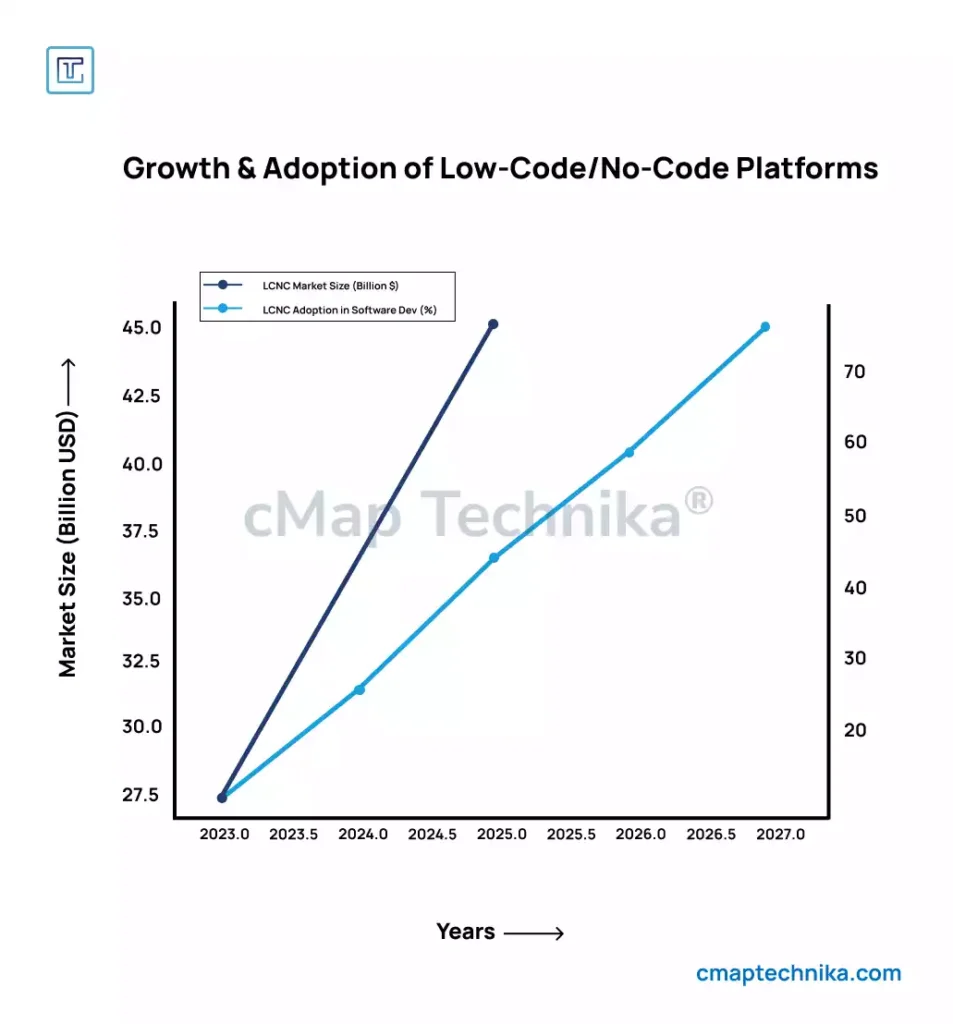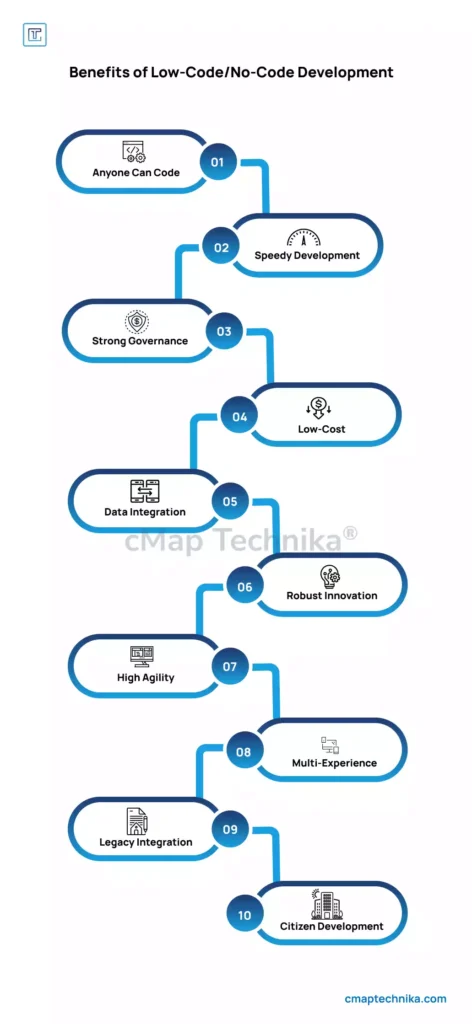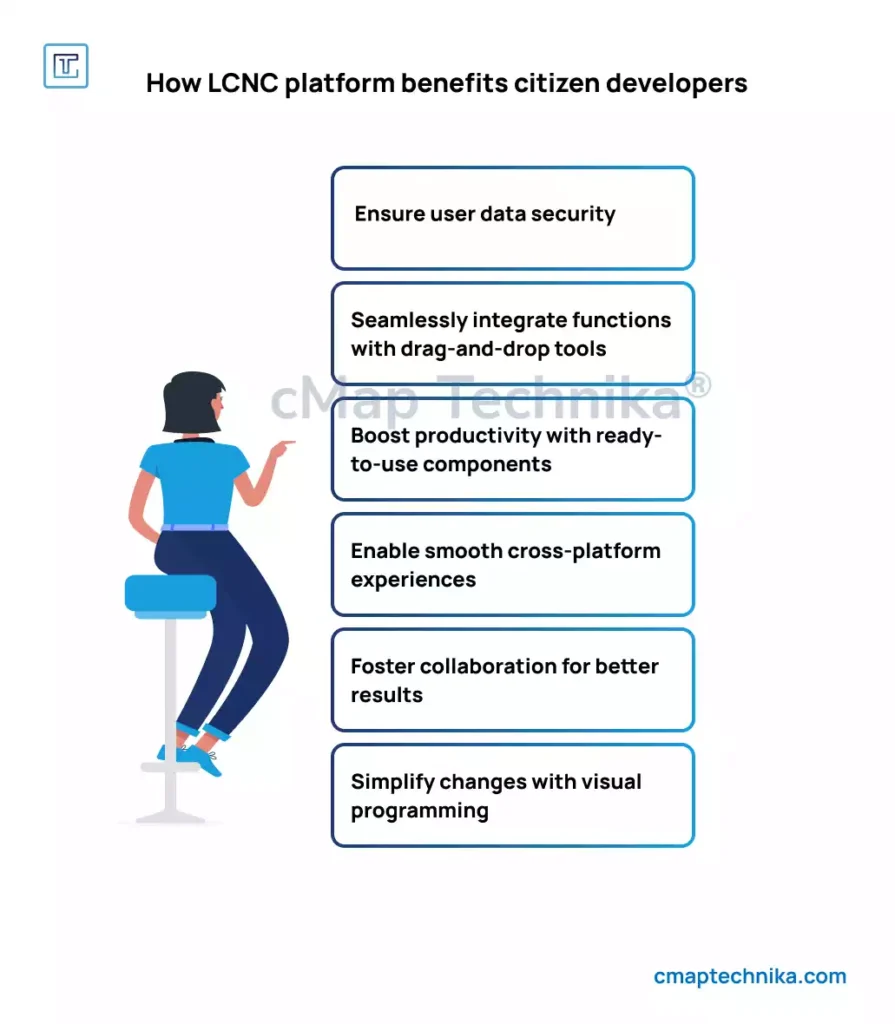1. Introduction
As organizations strive to keep pace with rapid digital transformation, the demand for faster, more efficient application development has surged. Traditional software development methods, often constrained by long development cycles and a reliance on skilled programmers, can no longer meet the agility requirements of modern businesses. To address these challenges, low-code and no-code (LCNC) platforms have emerged as game-changers, offering a visual, drag-and-drop approach to application development that significantly reduces the need for extensive coding expertise.
LCNC platforms empower businesses across industries by enhancing agility, reducing costs, and accelerating time-to-market. They enable citizen developers—business users with little to no programming knowledge—to create functional applications, thereby alleviating the burden on IT teams and fostering innovation across departments.
This report explores the transformative role of LCNC platforms in modern enterprises, analyzing their impact on development efficiency, adoption trends, key advantages, and limitations. By examining real-world use cases and industry data, we assess how LCNC platforms are revolutionizing software development and shaping the future of digital business solutions.
2. The Rise of Low-Code/No-Code Development

2.1 Defining Low-Code and No-Code
- Low-code platforms require minimal coding knowledge and allow developers to create applications using visual interfaces combined with pre-built logic and integrations.
- No-code platforms eliminate the need for coding entirely, enabling users to develop applications through intuitive drag-and-drop interfaces.
2.2 Growth and Market Trends
- According to industry research, the global LCNC market is expected to grow from $26.9 billion in 2023 to $45.5 billion by 2027.
- Over 65% of software development by 2025 is projected to be conducted using LCNC platforms.
- Industries adopting LCNC solutions include finance, healthcare, retail, and manufacturing.
3. Benefits of Low-Code/No-Code Platforms

In today’s fast-paced digital landscape, businesses need to innovate quickly while keeping costs and complexities low. Low-code and no-code development platforms are transforming the way applications are built, empowering organizations with speed, agility, and collaboration.
1. Faster Development Cycles
Traditional software development is time-intensive, but low-code/no-code platforms significantly reduce development time—often by 50-90%. With visual development tools and drag-and-drop interfaces, businesses can rapidly build and deploy applications.
2. Empowering More Users
With low-code/no-code solutions, anyone can build applications, from professional developers to business users. This shift, known as citizen development, allows organizations to scale innovation without relying solely on IT teams.
3. Strong Governance & Security
Governance and compliance are crucial in software development. Low-code/no-code platforms provide built-in security protocols, role-based access, and automated compliance checks, ensuring enterprise-grade protection while maintaining development agility.
4. Cost Efficiency
Developing software traditionally requires specialized developers, extensive testing, and ongoing maintenance. Low-code/no-code platforms reduce operational costs by minimizing custom coding and IT overhead, making software development more affordable and sustainable.
5. Seamless Data & Legacy System Integration
Modern businesses rely on diverse systems. Low-code/no-code platforms enable smooth integration with existing enterprise tools, databases, and legacy systems, ensuring a unified digital ecosystem.
6. Agility & Innovation
Businesses need to adapt quickly to market changes. Low-code/no-code platforms provide high agility, allowing organizations to rapidly prototype, test, and iterate solutions, fostering a culture of continuous innovation.
7. Multi-Experience Capabilities
Low-code/no-code platforms support multi-device and omnichannel experiences, ensuring seamless interaction across web, mobile, and desktop applications. This flexibility enhances customer and employee engagement.
By embracing low-code and no-code development, businesses can accelerate digital transformation, enhance collaboration, and drive operational efficiency, ultimately gaining a competitive advantage in the evolving technology landscape.
4. Challenges and Limitations
4.1 Security and Compliance Risks
- Concerns over data security, especially in highly regulated industries.
- Need for governance frameworks to ensure compliance.
4.2 Scalability Constraints
- Some LCNC solutions may struggle with complex enterprise-level applications.
- Performance limitations when handling large datasets.
4.3 Vendor Lock-In Risks
- Dependency on specific platforms may limit flexibility.
- Migration challenges if transitioning to custom-coded solutions.
5. Case Studies: Real-World Applications
As low-code and no-code (LCNC) platforms gain traction across industries, organizations are leveraging these tools to automate workflows, enhance customer engagement, and optimize operations. The following case studies illustrate how leading enterprises across financial services, healthcare, and retail have successfully implemented LCNC platforms to drive innovation, efficiency, and business transformation.
5.1 Financial Services: JPMorgan Chase – Automating Workflows and Enhancing Fraud Detection
Background
JPMorgan Chase, one of the largest financial institutions in the world, deals with millions of daily transactions, regulatory compliance mandates, and extensive risk management processes. Manual workflows in areas like document processing, client onboarding, and fraud detection were inefficient and time-consuming.
LCNC Implementation

To streamline operations, JPMorgan Chase adopted low-code platforms to automate internal processes, reducing reliance on traditional coding and IT backlog.
- Workflow Automation: LCNC tools were used to develop internal applications that automated repetitive tasks, such as loan processing, customer service request handling, and compliance reporting.
- Fraud Detection Enhancement: AI-powered LCNC solutions were integrated with real-time transaction monitoring systems, allowing the bank to quickly identify suspicious activities.
- Regulatory Compliance Acceleration: The institution leveraged no-code solutions to create custom dashboards for compliance reporting, reducing manual effort and ensuring accuracy.
Impact and Results
- 70% reduction in manual processes, leading to faster turnaround times.
- Increased fraud detection accuracy, minimizing financial losses and enhancing security.
- Improved agility in regulatory compliance, reducing reporting delays and enhancing transparency.
5.2 Healthcare: Mayo Clinic – Enhancing Patient Engagement and Telehealth Services
Background
Mayo Clinic, a globally renowned healthcare provider, sought to improve patient engagement, enhance telehealth services, and streamline data management. Traditional development cycles were slowing down digital health innovations, limiting the ability to rapidly deploy patient-centric solutions.
LCNC Implementation
Mayo Clinic leveraged no-code platforms to create intuitive patient engagement applications and enhance telehealth experiences.
- Patient Engagement Applications: A no-code platform was used to develop a self-service patient portal that allows users to schedule appointments, access medical records, and communicate with healthcare providers.
- Telehealth Optimization: LCNC solutions enabled the rapid deployment of virtual consultation interfaces, reducing dependency on IT teams for iterative improvements.
- Data Management and Integration: A low-code analytics dashboard was created to consolidate electronic health records (EHRs) and derive insights for personalized patient care.
Impact and Results
- Enhanced patient experience, reducing appointment scheduling time by 50%.
- Expanded telehealth services, improving access to remote healthcare.
- Efficient data management, enabling healthcare professionals to make informed decisions in real time.
5.3 Retail: Walmart – Optimizing Supply Chain and Inventory Management
Background
As one of the world’s largest retailers, Walmart faces massive operational complexities, particularly in supply chain and inventory management. With thousands of stores and warehouses, ensuring product availability while minimizing excess inventory was a constant challenge.
LCNC Implementation
To improve efficiency, Walmart adopted low-code platforms to develop real-time supply chain applications that provided visibility into inventory levels and automated decision-making.
- Inventory Management Optimization: A low-code system was developed to track stock levels in real time, automatically reordering high-demand products.
- Supply Chain Resilience: A no-code platform was used to create anomalous shipment detection tools, reducing supply chain disruptions.
- Operational Cost Reduction: LCNC-driven automated workflows streamlined warehouse operations, reducing reliance on manual data entry.
Impact and Results
- Reduced operational costs by 30% through automation and improved inventory control.
- Faster response to demand fluctuations, minimizing stockouts and overstocking.
- Improved supply chain efficiency, ensuring timely deliveries across thousands of locations.
Key Takeaways from LCNC Adoption
These case studies highlight the transformative impact of LCNC platforms across industries:
- Financial Services: Increased automation, better fraud detection, and enhanced compliance.
- Healthcare: Improved patient engagement, faster telehealth deployment, and streamlined data management.
- Retail: Optimized supply chain, cost savings
6. Future Outlook
The rapid evolution of low-code and no-code (LCNC) platforms is set to redefine how businesses approach software development. As technological advancements continue to enhance the capabilities of these platforms, their adoption is expected to expand beyond small-scale applications into large enterprise ecosystems. Key trends shaping the future of LCNC include the integration of artificial intelligence, the expansion of enterprise-grade solutions, and the rise of hybrid development models that blend no-code, low-code, and traditional programming approaches.
6.1 AI-Driven LCNC Development
Artificial intelligence (AI) is increasingly being integrated into LCNC platforms, enabling smarter automation, predictive analytics, and AI-assisted development workflows. Emerging AI-driven features will further reduce manual intervention, allowing users to build more sophisticated applications with minimal technical expertise.
- Smarter Automation and Predictive Analytics: AI-powered LCNC platforms will analyze user behavior, suggest optimizations, and automate repetitive tasks. This will improve efficiency in application development by dynamically adjusting workflows based on usage patterns and real-time data insights.
- AI-Assisted Code Generation: While LCNC platforms already minimize the need for manual coding, AI will further enhance customization by automatically generating or modifying code snippets where necessary. This will enable greater flexibility while maintaining ease of use, bridging the gap between citizen developers and traditional software engineers.
As AI continues to evolve, LCNC platforms will become more intelligent, adaptive, and capable of handling increasingly complex application requirements.
6.2 Expansion into Enterprise Solutions
Traditionally, LCNC platforms have been associated with small-scale applications and process automation. However, large enterprises are now leveraging these platforms for mission-critical applications, ranging from customer relationship management (CRM) to enterprise resource planning (ERP) solutions.
- Enterprise Adoption for Large-Scale Deployments: Organizations are increasingly recognizing LCNC as a viable solution for scaling digital initiatives, improving agility, and reducing development costs. The ability to quickly adapt to business needs and deploy enterprise-grade applications is making LCNC platforms a strategic investment for large corporations.
- Governance and Security Enhancements: As LCNC adoption grows within regulated industries such as healthcare, finance, and government sectors, governance frameworks and security enhancements will become a priority. Vendors are expected to introduce advanced security controls, compliance features, and audit mechanisms to ensure enterprise-level protection and mitigate risks associated with shadow IT.
The shift towards enterprise-grade LCNC solutions will enable businesses to build, deploy, and scale mission-critical applications while ensuring compliance and security.
6.3 Hybrid Development Models
While LCNC platforms empower non-technical users, certain complex applications still require advanced customization and integration with traditional development methodologies. As a result, organizations are increasingly adopting hybrid development models that combine the strengths of LCNC with traditional software engineering.
- Blending LCNC with Traditional Coding: Developers are integrating LCNC platforms into existing development workflows, allowing citizen developers to create functional prototypes while professional developers refine the underlying architecture and add custom features. This approach enhances collaboration between IT and business teams, ensuring that applications meet both functional and technical requirements.
- Encouraging Developer Collaboration: Rather than replacing traditional development entirely, LCNC platforms are enabling a collaborative ecosystem where citizen developers handle front-end logic while professional developers manage complex integrations, APIs, and backend systems. This model fosters greater innovation, faster deployment cycles, and improved application performance.
By embracing hybrid development approaches, organizations can strike a balance between rapid application delivery and technical robustness, ensuring that LCNC platforms complement rather than replace traditional software engineering practices.
7. Conclusion
Low-code and no-code (LCNC) platforms are fundamentally transforming the software development landscape, democratizing application creation, accelerating digital transformation, and bridging the gap between business and IT teams. By reducing reliance on traditional coding, these platforms empower organizations to rapidly prototype, iterate, and deploy solutions, driving efficiency and cost savings.
However, despite their numerous advantages, challenges such as security risks, scalability concerns, and governance complexities remain. As AI-driven automation and enterprise-grade LCNC solutions continue to evolve, many of these limitations are being actively addressed, making these platforms more viable for complex and large-scale applications.
Organizations that strategically integrate LCNC platforms into their digital ecosystems—by implementing strong governance frameworks, prioritizing security, and fostering cross-functional collaboration—will unlock new levels of innovation and agility. As businesses continue to navigate the demands of an increasingly digital economy, LCNC platforms will serve as catalysts for growth, efficiency, and long-term success.
8. References
- Gartner, “The Future of Low-Code and No-Code Development,” 2023.
- Forrester Research, “The Impact of No-Code on Enterprise IT,” 2024.
- McKinsey & Company, “Digital Transformation with Low-Code/No-Code Platforms,” 2024.
This research report provides a comprehensive analysis of LCNC platforms, their benefits, challenges, and real-world applications. It serves as a valuable resource for organizations looking to leverage LCNC solutions for digital transformation.






